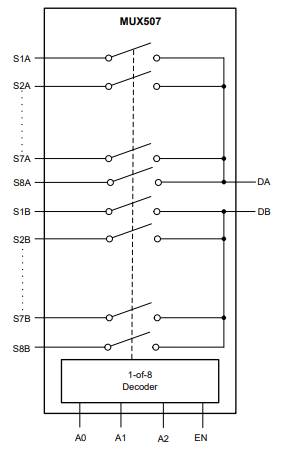Other Parts Discussed in Thread: DRV8847, , SN74CBT3251, MUX507
Hello, I'm trying to search for a 1:8 demux from TI.
I use MSP430G2 launchpad to generate PWM signals (10 ~ 10kHz, 1~60% duty cycle) and this is connected to a motor driver DRV8847 to control brushed DC motors.
I'm using 20V power supply to power the motor driver.
I have 8 DC motors to control. Instead of populating multiple motor drivers, I wanted to use a single motor and use two 1:8 demux to reroute the PWM signals.
May I ask
Q0. Can I use two CD4051B-Q1 (CD4051BQPWRQ1; one for each DC motor pins) to choose which motor to run with a single 20V motor driver?
I noticed CD4051B-Q1's max supply voltage is also 20V.
Q1. The MSP430G2 has 3.3V GPIO. Can I control CD4051B-Q1's input channel A/B/C with the 3.3V GPIOs when supplying 20V to CD4051B-Q1?
I hope I'm following the voltage rating correctly.
Q2. Can I set VEE=VSS=GND for my case?
Q3. Pin 3 - COMMON IN/OUT; is this the data input pin, for my case the 20V PWM signal goes here?
Q4. Referring the SN74CBT3251's functional diagram (NAND gate + N Channel MOSFET), does CD4051B-Q1 also have the same configuration as well?












